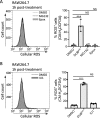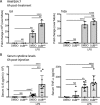Perturbation of ubiquitin homeostasis promotes macrophage oxidative defenses
- PMID: 31308397
- PMCID: PMC6629656
- DOI: 10.1038/s41598-019-46526-9
Perturbation of ubiquitin homeostasis promotes macrophage oxidative defenses
Abstract
The innate immune system senses microbial ligands through pattern recognition and triggers downstream signaling cascades to promote inflammation and immune defense mechanisms. Emerging evidence suggests that cells also recognize alterations in host processes induced by infection as triggers. Protein ubiquitination and deubiquitination are post-translational modification processes essential for signaling and maintenance of cellular homeostasis, and infections can cause global alterations in the host ubiquitin proteome. Here we used a chemical biology approach to perturb the cellular ubiquitin proteome as a simplified model to study the impact of ubiquitin homeostasis alteration on macrophage function. Perturbation of ubiquitin homeostasis led to a rapid and transient burst of reactive oxygen species (ROS) that promoted macrophage inflammatory and anti-infective capacity. Moreover, we found that ROS production was dependent on the NOX2 phagocyte NADPH oxidase. Global alteration of the ubiquitin proteome also enhanced proinflammatory cytokine production in mice stimulated with a sub-lethal dose of LPS. Collectively, our findings suggest that major changes in the host ubiquitin landscape may be a potent signal to rapidly deploy innate immune defenses.
Conflict of interest statement
The authors declare no competing interests.
Figures







Similar articles
-
Fas-associated factor 1 mediates NADPH oxidase-induced reactive oxygen species production and proinflammatory responses in macrophages against Listeria infection.PLoS Pathog. 2019 Aug 14;15(8):e1008004. doi: 10.1371/journal.ppat.1008004. eCollection 2019 Aug. PLoS Pathog. 2019. PMID: 31412082 Free PMC article.
-
Oregano Essential Oil Attenuates RAW264.7 Cells from Lipopolysaccharide-Induced Inflammatory Response through Regulating NADPH Oxidase Activation-Driven Oxidative Stress.Molecules. 2018 Jul 26;23(8):1857. doi: 10.3390/molecules23081857. Molecules. 2018. PMID: 30049950 Free PMC article.
-
Control of SUMO and Ubiquitin by ROS: Signaling and disease implications.Mol Aspects Med. 2018 Oct;63:3-17. doi: 10.1016/j.mam.2018.07.002. Epub 2018 Aug 4. Mol Aspects Med. 2018. PMID: 30059710 Review.
-
Neutrophils to the ROScue: Mechanisms of NADPH Oxidase Activation and Bacterial Resistance.Front Cell Infect Microbiol. 2017 Aug 25;7:373. doi: 10.3389/fcimb.2017.00373. eCollection 2017. Front Cell Infect Microbiol. 2017. PMID: 28890882 Free PMC article. Review.
-
NRROS negatively regulates reactive oxygen species during host defence and autoimmunity.Nature. 2014 May 8;509(7499):235-9. doi: 10.1038/nature13152. Epub 2014 Apr 13. Nature. 2014. PMID: 24739962
Cited by
-
Osteopontin depletion in macrophages perturbs proteostasis via regulating UCHL1-UPS axis and mitochondria-mediated apoptosis.Front Immunol. 2023 May 30;14:1155935. doi: 10.3389/fimmu.2023.1155935. eCollection 2023. Front Immunol. 2023. PMID: 37325640 Free PMC article.
-
Innate control of adaptive immunity and adaptive instruction of innate immunity: bi-directional flow of information.Curr Opin Immunol. 2021 Dec;73:25-33. doi: 10.1016/j.coi.2021.07.013. Epub 2021 Aug 20. Curr Opin Immunol. 2021. PMID: 34425435 Free PMC article. Review.
-
Importance of Deubiquitination in Macrophage-Mediated Viral Response and Inflammation.Int J Mol Sci. 2020 Oct 29;21(21):8090. doi: 10.3390/ijms21218090. Int J Mol Sci. 2020. PMID: 33138315 Free PMC article. Review.
-
AR ubiquitination induced by the curcumin analog suppresses growth of temozolomide-resistant glioblastoma through disrupting GPX4-Mediated redox homeostasis.Redox Biol. 2020 Feb;30:101413. doi: 10.1016/j.redox.2019.101413. Epub 2019 Dec 26. Redox Biol. 2020. PMID: 31896509 Free PMC article.
-
Ubiquitin-related processes and innate immunity in C. elegans.Cell Mol Life Sci. 2021 May;78(9):4305-4333. doi: 10.1007/s00018-021-03787-w. Epub 2021 Feb 25. Cell Mol Life Sci. 2021. PMID: 33630111 Free PMC article. Review.
References
Publication types
MeSH terms
Substances
Grants and funding
LinkOut - more resources
Full Text Sources
Molecular Biology Databases
Miscellaneous

